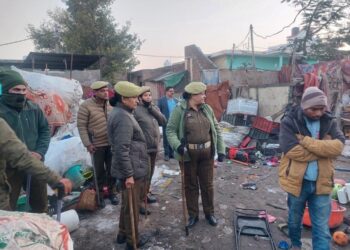 Representational Photo
Representational Photo
Amid shocking suicides, the distressing drowning deaths have so far come to define the scorching summer in the valley. With mercury soaring and young boys beating the heat by diving into water bodies, experts fear more fatal consequences.
IT was the second day of Eid-ul-Azha, when fresh-faced Manzoor Raise of Khanabal Kupwara left home amid festivity. The breadwinner of his old parents and two younger siblings had felt compelled to come out for the sake of his underprivileged family.
But his survival outing shortly involved him in a rescue mission ending up consuming the sole support of his family.
Near Kehmil Nallah in his hometown, he saw a mother-daughter duo struggling to cross the temporary bridge — about which many had raised concern fearing the fatal consequences. The bridge had chosen the breadwinner as its victim on Eid.
Manzoor’s ‘social worker’ spirit didn’t allow him to ignore the duo.
He helped cross the daughter with ease, but her mother stumbled on the troubled bridge and fell into the gushing water body. Manzoor instantly jumped to rescue the lady — but neither he, nor the lady could come out alive.
Before drowning, Manzoor had saved many lives. But as his luck ran out on Eid, his family was torn asunder by grief and existential crisis.
But what happened at Kupwara wasn’t the first instance of drowning in Kashmir this summer. Alongside suicides, the rate of drowning deaths is also escalating in the valley.
On 14 July 2021, two teenage cousin sisters—Utba (17) and Insha (19)—drowned after a sudden flow of water to a power canal washed them away at Ferozpur Nallah in Drang tourist resort.
It was the birthday of one of the deceased girls, who had insisted on going for the picnic.
“I was just standing near the Nallah and watching my children talking Selfies,” Yasmeena Khan, mother of Utba told Kashmir Observer. “Suddenly, a water gush washed them away. Everything happened so fast that we failed to act and react.”
What followed was a quintessential tragic tale—leaving another Kashmiri family with loss and lamentations.
But apart from sudden drowning incidents, many say surging life attempts in water bodies of Kashmir is also escalating the rate of such deaths. “It’s not always easy for even a seasoned swimmer to rescue a drowning person,” said Sajad Shangloo, a fisherman with dozens of rescue ops to his name. “These are tiring rescue ops, which often end up consuming the rescuer himself.”
Above and beyond these suicide-triggered drowning cases, a summertime heat-relieving dives into rivers, ponds, lakes and streams are also creating these casualties.
“If you don’t know swimming, why to jump into the water,” said Riyaz Wani, a professional swimmer. “This is suicide.”
Apart from lack of training, Wani said, dearth of life-saving equipment in Kashmir is equally responsible for these deaths.
“Drowning incidents happen in other states as well, but authorities deploy life-saving guards there to prevent such mishaps,” he said. “However, here we don’t have such facilities.”
A member of Swimming and Surviving Society—an NGO imparting swimming training and recording the drowning incidents—Wani said the ongoing summer already recorded 35 drowning deaths in different parts of the valley.
“Except seven, rest died,” he said. “And most of the deceased were teenagers.”
With “only 3 per cent Kashmiris well-versed with swimming”, Wani said, he fears more drowning cases as the soaring mercury is compelling youngsters to beat the heat in water bodies.
However, to prevent drowning deaths, the administration in Kashmir has restricted swimming at water bodies.
The disaster management department in its latest advisory has said that people should not venture out into the water bodies unless they know how to swim.
“Don’t dive into the water or push someone into the water,” it said. “Don’t swim alone, especially if you are an inexperienced swimmer.”
The current may be faster, the advisory warns, with dangerous undercurrents, even difficult for experienced swimmers.
“A rope, lifejacket, lifebuoy, or improvised flotation device should be made available for rescue operations at places where drowning incidents happen,” Aamir Ali, Disaster Management Director, told Kashmir Observer. “Elders should keep a constant visual contact with children when they are swimming. Learn first aid as you might save someone’s life.”
However, the biggest issue—the lack of life-saving support in Kashmir—has already doomed Manzoor’s poor family.
“It was a preventable loss,” said his mournful friend, Mushtaq Ahmad. “But the temporary bridge and the gushing water made his death certain. A posted guard could have saved the precious life, but alas!”
Follow this link to join our WhatsApp group: Join Now
Be Part of Quality Journalism |
Quality journalism takes a lot of time, money and hard work to produce and despite all the hardships we still do it. Our reporters and editors are working overtime in Kashmir and beyond to cover what you care about, break big stories, and expose injustices that can change lives. Today more people are reading Kashmir Observer than ever, but only a handful are paying while advertising revenues are falling fast. |
| ACT NOW |
| MONTHLY | Rs 100 | |
| YEARLY | Rs 1000 | |
| LIFETIME | Rs 10000 | |










